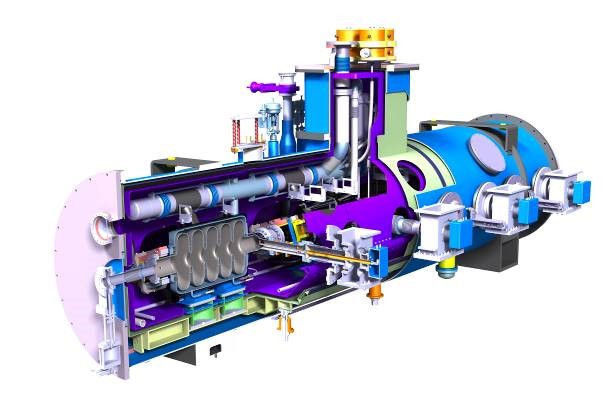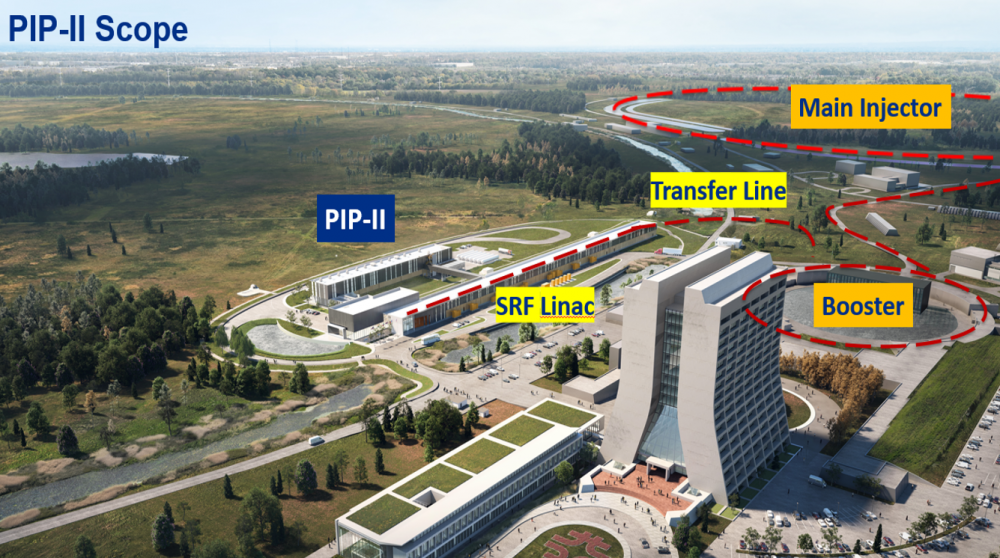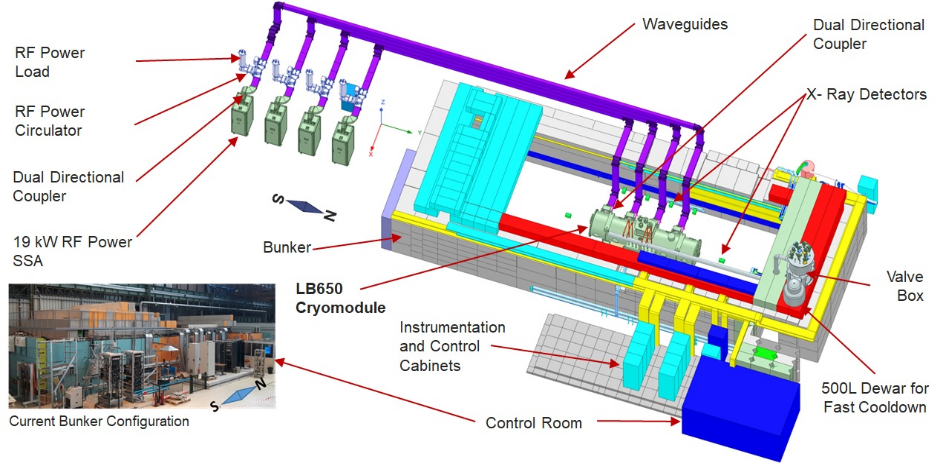The PIP-II (Proton Improvement Plan-II) project is the first particle accelerator to be built in the United States with major in-kind contributions from international partners. CEA/IRFU provides its expertise in the field of superconducting radio-frequency cryomodules and associated technologies. CEA/IRFU has been involved in this project since 2018, with a major contribution to the LB650 superconducting accelerator section, including the design studies, manufacture, and qualification of 10 cryomodules (each of them housing 4 superconducting accelerating cavities), i.e. 1 pre-production cryomodule and the 9 production cryomodules of the accelerator. A major milestone in the CEA/IRFU project was reached in April 2023, with the final design review of the LB650 cryomodule, validating 5 years of design activities. The project is now entering the pre-production cryomodule construction phase.
The PIP-II project
The PIP-II project is building a brand-new 800 MeV linear accelerator (linac) to inject protons into the Booster at the U.S. Department of Energy’s Fermi National Accelerator Laboratory. It will use innovative superconducting radiofrequency (RF) technologies and will replace the existing 400 MeV linac. This new linac is also designed to be compatible in the future with an increase in the power of the LBNF/DUNE beam to 2.4 MW (with a plan to replace the 8 GeV Booster) and more generally with continuous operation in order to optimise the capacities of the accelerator complex.
The linear accelerator in the PIP-II project consists of:
- a 2.1 MeV injector consisting of a source of 30 keV protons (H-), a low-energy line, an RF cavity operating at a frequency of 162.5 MHz and a medium-energy line for injecting into the superconducting linac ;
- a main linac that is approximately 180-meter long, comprising 5 families of superconducting cavities housed in cryomodules. These different families are designed to optimise proton acceleration in the 2.1 MeV - 833 MeV range:
- first, a cryomodule with half-wave cavities (HWR) at 162.5 MHz accelerating to 10.3 MeV,
- next, a family of two types of cryomodules housing the so-called Spoke cavities at 325 MHz (SSR1, SSR2) accelerating to 185 MeV,
- lastly, a family of two types of cryomodules housing the elliptical cavities at 650 MHz to reach the final energy.
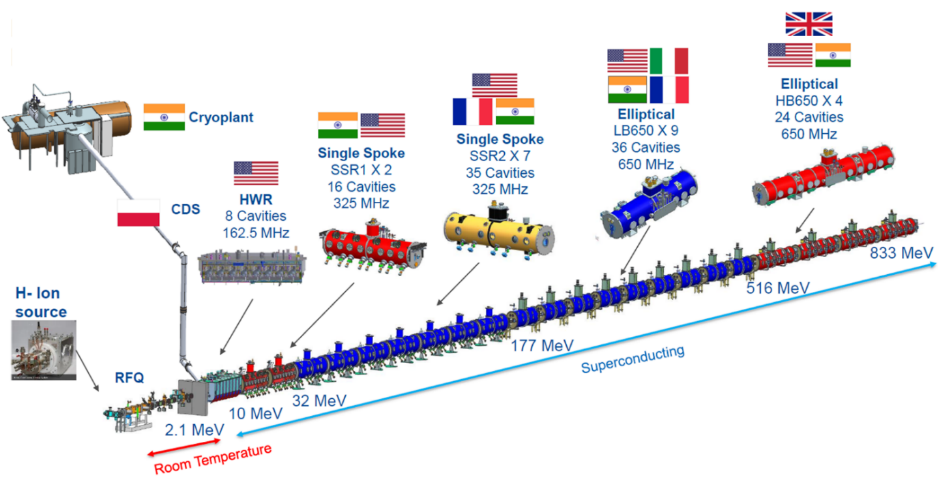
The LB650 cryomodule, a contribution from CEA/IRFU
The LB650 cryomodules is the fourth type of cryomodule in the superconducting section of the PIP-II linear accelerator. Each type incorporates 4 superconducting β=0.61 cavities at a frequency of 650 MHz. These cavities are in-kind contributions from INFN (Italy) and VECC (India), while the frequency tuning systems and power couplers are supplied by Fermilab.
A cryomodule is a complex mechanical and cryogenic system used to accelerate the proton beam. It has two main functions:
- Cool down and keep the superconducting cavities at their operating temperature (1.8 K or -271.35°C) while limiting the heat loads to be as low as possible (thermal efficiency);
- Provide mechanical housing for the superconducting cavities with respect to the alignment requirements of the beam dynamics.
Mechanical and thermal functions are very often conflicting, so the design of such a system is a compromise between them.
The figure on the left side shows a cross-section of the PIP-II LB650 cryomodule. The four cavities are mechanically supported by an assembly consisting of titanium posts, cavity posts that provide thermal insulation between the warm and cold parts and are made of G11 material — a continuous filament glass cloth material with an epoxy resin binder — and a mechanical structure called strongback. The strongback remains at ambient temperature, ensuring that the cavity train remains aligned as the cryomodule cools. This support principle, developed by Fermilab, is used on most of the cryomodules in the PIP-II accelerator.
Since the cavities are sensitive to the surrounding magnetic field, they must be protected with magnetic shielding. They are cooled to cryogenic temperature by circulating liquid helium through piping, then the whole system is placed in a vacuum vessel, which limits the amount of heat generated by convection. A thermal shield, cooled by helium gas at 50 K (-223.15°C), is inserted between the vacuum vessel at ambient temperature (293.15 K or 20°C) and the cavities, thus limiting heat transfer by thermal radiation.
Close collaboration between CEA/Irfu and Fermilab
Since the LB650 (Low beta) cryomodule is very similar to the HB650 (High beta) cryomodule developed by Fermilab, it was important for the CEA/Irfu to follow the HB650’s development in order to gain as much experience as possible — mainly with the strongback, which is a new way of supporting cavities compared with previous cryomodules developed by CEA/Irfu.
- Firstly, the CEA/Irfu was involved in the international team designing the HB650 cryomodule, specifically responsible for the mechanical and thermal design of the strongback.
- Secondly, the CEA/Irfu assembly team closely followed the assembly of the HB650 prototype cryomodule at Fermilab by carrying out a number of observation trips throughout 2022.
- Finally, the CEA/Irfu cryomodule testing team went to Fermilab in April 2023 to observe the cold RF testing of the HB650 prototype cryomodule.
Feedback from the assembly was implemented on the design of the LB650 cryomodule during the first quarter of 2023. The Final Design Review was held at the beginning of April, in which a committee of five international experts critically examined the cryomodule design and the organisation of the project at the CEA. At the end of this review, the committee considered the design of the LB650 cryomodule to be sufficiently mature. This important milestone for the CEA/IRFU ends the design phase and launches the construction phase of the pre-production cryomodule.
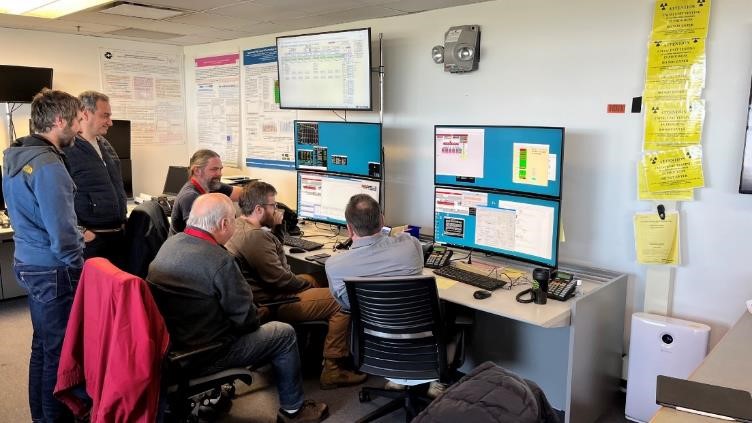
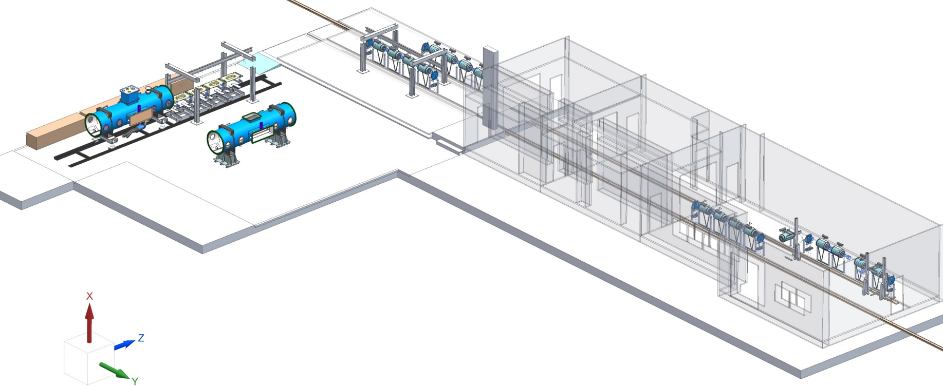
The various workstations for assembling the LB650 cryomodules in the IRFU buildings. (Credit : IRFU)
On to the next stage of the project
In parallel with the design activities on the LB650 cryomodule, major efforts have been made to prepare the assembly and cold RF testing of the future cryomodules at CEA/IRFU. These cryomodules will be assembled and tested in Irfu's existing infrastructure, currently used by the ESS project and upgraded to meet the PIP-II project criteria. The cavity strings will be assembled in the ISO4 clean room, with the cold mass assembly and insertion of the assembly into the vacuum vessel taking place in the adjacent hall.
Assembly studies and the design of the associated tooling began shortly after the launch of the cryomodule design, enabling the interfaces between the cryomodule components and the tooling to be defined and to adapt the design of some components in order to ease the assembly operations.
The cryomodule tests will be carried out on the Supratech Cryo/HF test platform and in the test cave currently used for the ESS and SARAF cryomodules. The test cave will be adapted to meet the needs of the project. The cryogenic system at the Supratech facility will also be upgraded to meet the cooling requirements of the PIP-II cryomodules.
The procurement of the components of the cryomodules started mid-2023. The first contracts for the manufacturing will be awarded at the beginning of 2024.
In 2022, the contract for the procurement of four 19 kW solid-state RF amplifiers was awarded to Jema France, and the contract to replace the current cold box (used to produce liquid helium) to Air Liquide.
Assembly of the pre-production cryomodule should begin at the end of 2024 or beginning of 2025. The commissioning of the PIP-II accelerator at Fermilab is currently scheduled for late 2028.
Contact: Nicolas Bazin
• Accelerator physics and technology › R&D and Instrumentation for Future Accelerators
• Accelerators, Cryogenics and Magnetism Division (DACM)
• LIDC2



